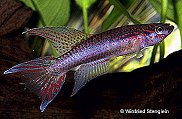Excerpted from "
Karyotype differentiation in Chromaphyosemion killifishes (Cyprinodontiformes, Nothobranchiidae). II: Cytogenetic and mitochondrial DNA analyses demonstrate karyotype differentiation and its evolutionary direction in C. riggenbachi"
(Page 81 Paragraph 3)"However, even assuming that the SA (2n = 30, NF = 44) and WN (2n = 20, NF = 40) populations were the same as the karyotypically similar populations investigated in this study,
C. riggenbachi would still comprise at least seven karyotypically different populations, namely the five populations examined here and the YA (2n = 38, NF = 38) and GI (2n = 34, NF = 38) populations investigated by Scheel. Assuming that the pattern of karyotype and haplotype differentiation identified in the present study holds true for
C. riggenbachi in general, it is tempting to speculate that the 2n = 38, NF = 38 karyotype, possibly comprising 38 euchromatic arms, may represent the ancestral
C. riggenbachi karyotype. However, this hypothesis cannot be tested at present since no live offspring of the
specimens sampled by Scheel are available for cytogenetic analyses and the preserved material is not suitable for molecular studies"
- M. Völker, R. Sonnenberg, P. Ráb, and H. Kullmann in "Karyotype differentiation in
Chromaphyosemion killifishes (Cyprinodontiformes, Nothobranchiidae). II: Cytogenetic and mitochondrial DNA analyses demonstrate karyotype differentiation and its evolutionary direction in
C. riggenbachi" (
PDF)
|
(Page 71) Table 2. Chromosomal characteristics of nine Chromaphyosemion riggenbachi populations. Data from present study
(KV03/16, KV03/27, KV03/25, KV03/28, KV03/29), Scheel (1974) (YA, GI, SA) and Scheel (1990) (WN). Chromosomes
were classified into groups (a), (b) and (c) as in Fig. 1. |
|
Population |
2n |
NF |
No. of group (a) chromosomes |
No. of group (b) chromosomes |
No. of group (c) chromosomes |
No. of ec. armsa |
No. of hc. armsa |
|
KV03/16 | 36 | 40 | 2 | 2 | 32 | 38/37 | 2/3 |
| KV03/27 | 30/31 | 44 | 8/7 | 8 | 14/16 | 36 | 8 |
| KV03/25 | 24 | 44 | 12 | 8 | 4 | 36 | 8 |
| KV03/28 | 20 | 40 | 16 | 4 | 0 | 36 | 4 |
| KV03/29 | 20 | 40 | 16 | 4 | 0 | 36 | 4 |
| YA | 38 | 38 | n/a | n/a | n/a | n/a | n/a |
| GI | 34 | | 38 | n/a | n/a | n/a | n/a |
| SA | 30 | 44 | n/a | n/a | n/a | n/a | n/a |
| WN | 20 | 40 | n/a | n/a | n/a | n/a | n/a |
|















